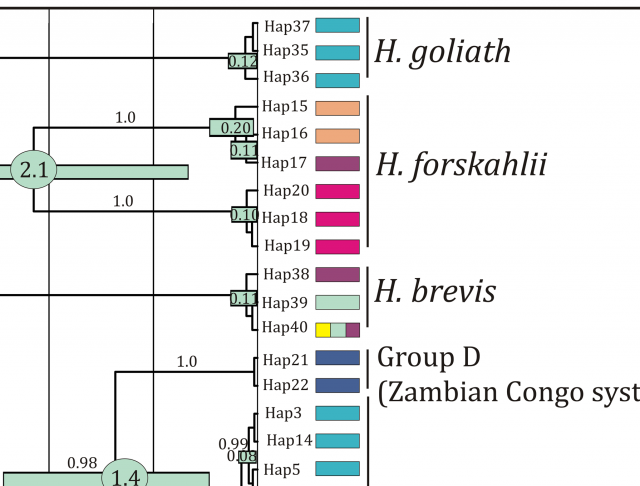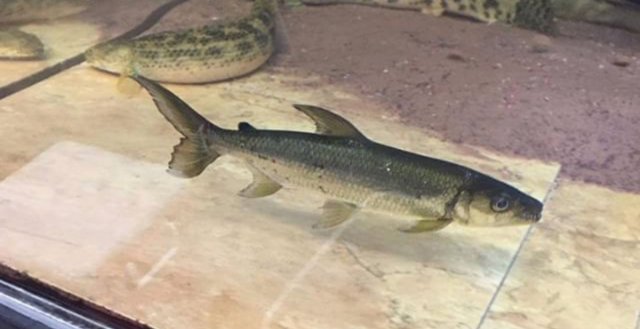Ahhh gents, sorry to join the conversation late. I've been exceptionally busy with work. I don't know where to find it as I don't read Chinese either but if you do and you search on Chinese search engines such as baidu they discuss about true Congo goliaths vs normal goliaths. They have distinct body differences being broader top down compared to the skinnier profile. They also have different snout shapes. There may be even more than these two as there's usually one or two of the cryptic black goliaths mixed into a batch of 500-1000 juvies when the come in. Little is shown about it in captivity because most don't make it alive to adult or subadult sized. I can attest from first hand experience keeping so many ATFs now. Sometimes they are just mixed into batches that you have to eyeball and spot. I got my brasiliensis dorado out of a school of Frankie's. took almost half an hour or selective net out lol. All this talk sure makes me miss my old monster...
Six GATF from Wes
- Thread starter thebiggerthebetter
- Start date
Pic #1 is a GATF in low light, black tank conditions. #2 is a black Goliath. I won't say who had it, butI haven't given up hope that a cryptic black goliath population exists. Indeed, I think they're already in the hobby, just not under ideal conditions for expression of the color. This also comes back as direct support for the idea that there's two lineages
Please pm me about that fish. I'm pretty sure I know who you're talking about. I've spent six years trying to sort out the black goliath question, and this is my first real lead outside of my phone calls with Douglas Dann in 2013.Pic #1 is a GATF in low light, black tank conditions. #2 is a black Goliath. I won't say who had it, butUnstoppableJayD and I saw an actual black goliath a few years ago. Even at a small size, the fish was black.
As for the first fish, that one was mine. He read did turn black, but only in heavily tannin stained blackwater (per what Mr. Dann told me about his blacks). As soon as I put carbon in the tank to clear the water up, he turned grey again in just a few days. I've got a couple more pics on my computer of him in clear water with better lighting when he was lightening up, but was still far darker than anything else we normally see.
If my hypothesis about black goliaths is wrong (and not only is that very possible, I HOPE it is) and they really do exist in pure black form, I'm willing to spend an absolutely asinine amount of money to have one.
Ok that makes sense. I have noticed the exact same thing about the shape of the gatfs we get in the hobby as well. I got all excited because I thought something scientific was published that escaped my attention and I wanted to gobble it up.Ahhh gents, sorry to join the conversation late. I've been exceptionally busy with work. I don't know where to find it as I don't read Chinese either but if you do and you search on Chinese search engines such as baidu they discuss about true Congo goliaths vs normal goliaths. They have distinct body differences being broader top down compared to the skinnier profile. They also have different snout shapes. There may be even more than these two as there's usually one or two of the cryptic black goliaths mixed into a batch of 500-1000 juvies when the come in. Little is shown about it in captivity because most don't make it alive to adult or subadult sized. I can attest from first hand experience keeping so many ATFs now. Sometimes they are just mixed into batches that you have to eyeball and spot. I got my brasiliensis dorado out of a school of Frankie's. took almost half an hour or selective net out lol. All this talk sure makes me miss my old monster...
Most interestingly of all is this. While genetically there is only one species of Hydrocynus goliath, there are three unique haplotypes. Haplotypes- a set of genetic data that tends to be passed on to descendants- can be distinct, but are far less than a subspecies, think of them like breeds of dog.

There may be something to this. The article from which that image came stated that based on genetic evidence, Hydrocynus goliath has undergone a population explosion in geologically recent times. This could be the very earliest parts of sympatric speciation, even though at this point they're definitely all still gatfs.
Should we, as a community, start thinking of them as morphs? As I prepare to rewrite the sticky, that's a particularly relevant question.
Thanks for all the info. Definitely refreshing to see such passion and care. Even with the disagreements no ones areguing just people trying to get more information and smarter in the process. Hats off to you fellas this is how MFK should be used.
A friend of mine had a true black Goliath. I’ll try and ask him for a pic.Variants is a better word. The more I think about it, the more I'm on board with this idea. It definitely needs more research though.
I'd kill to see definitive proof of the cryptic blacks as being real.
Edit: this is it,

Last edited:
Very interesting! Some mitochondrial DNA analysis should be in order...
Recently we had a huge discussion on polypterus, and it appears that they are extremely malleable to their environment and even a single specimen can vary hugely in different environments. Could this not be similar for ATF? Black could always be mood, health condition, food, environmental conditions etc.
Just an idea? I'll never know because tigerfish from other countries are illegal, maybe I could get some VATF hehe
Recently we had a huge discussion on polypterus, and it appears that they are extremely malleable to their environment and even a single specimen can vary hugely in different environments. Could this not be similar for ATF? Black could always be mood, health condition, food, environmental conditions etc.
Just an idea? I'll never know because tigerfish from other countries are illegal, maybe I could get some VATF hehe
That fish looks very similar to my Max in both color and shape, but it doesn't appear to have lost it's color in clear water. I find that very interesting. I wonder if the water needed to simply be soft instead of black. I didn't try that.A friend of mine had a true black Goliath. I’ll try and ask him for a pic.
Edit: this is it,JLSEF9 ’s old guy.
View attachment 1281580
The paper from which I drew most of my conclusions about atf for the sticky and from which I continue to draw conclusions was a huge mtDNA study from all over Africa. ATF do indeed have a whole buttload of genetic variability. There are at least six unique undescribed genetic groups that could be species or subspecies. There's also considerable variability within the groups as well.Very interesting! Some mitochondrial DNA analysis should be in order...
Recently we had a huge discussion on polypterus, and it appears that they are extremely malleable to their environment and even a single specimen can vary hugely in different environments. Could this not be similar for ATF? Black could always be mood, health condition, food, environmental conditions etc.
Just an idea? I'll never know because tigerfish from other countries are illegal, maybe I could get some VATF hehe
There's quite a bit of work left to be done, and I hope to possibly do my small part of it.









